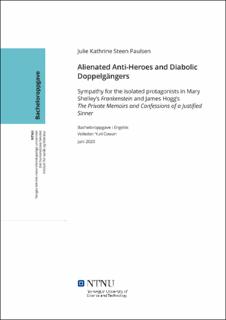| dc.contributor.advisor | Cowar, Yuri | |
| dc.contributor.author | Paulsen, Julie Kathrine Steen | |
| dc.date.accessioned | 2020-07-28T16:00:42Z | |
| dc.date.available | 2020-07-28T16:00:42Z | |
| dc.date.issued | 2020 | |
| dc.identifier.uri | https://hdl.handle.net/11250/2670352 | |
| dc.description.abstract | Oppgaven baserer seg på en analyse av to ikoniske britiske dobbeltgjengerromaner fra tidlig attenhundretall. Oppgaven tar for seg bruken av isolasjon som litterært virkemiddel i Mary Shelleys Frankenstein fra 1818 og James Hoggs The Private Memoirs and Confessions of a Justified Sinner fra 1824. I oppgaven heveder jeg at Hogg og Shelleys bruk av isolasjon og fremmedgjøring, fremkaller sympati for en ellers usympatisk protagonist. Både Victor Frankenstein og Robert Wringhim har fra bardommen av slitt med å relatere til både foreldre of jevngamle, og dermed har de heller ikke utviklet særlige sosiale evner. Den sosiale fremmedgjøringen fører til at protagonistene heller fokuserer på isolerende bestrebelser. Denne isolasjonen legger videre til rette for at doppeltgjengerne oppstår. Dobbeltgjengerne Gil-Martin og the «Creature» oppstår for å kompensere for mangelen på sosial stimuli, og for å oppfylle en rolle som følgesvenn. Deres nærver, intensiverer forøvrig bare isolasjonen, og til slutt blir de kilden til hovedpersonenes undergang. Ved å illustrere hvordan hovedpersonene er offer for egen mangel på evne til å sosialisere, samt samfunnets manglende evne til å fange opp dette, utvikler leseren sympati for disse naive og narissistiske protagonistene som møter døden i ensomhet og nederlag. | |
| dc.description.abstract | The paper is based on an analysis of two iconic British doppelgänger novels from the early nineteenth century. The paper explores the use of isolation and alienation as literary devices in Mary Shelley’s Frankenstein from 1818 and James Hogg’s The Private Memoirs and Confessions of a Justified Sinner from 1824. I claim that Hogg and Shelley’s use of isolation and alienation evoke sympathy for otherwise unsympathetic protagonists. Both Victor Frankenstein and Robert Wringhim have since childhood struggled to connect with both parents and peers and thus fail to develop appreciable social skills. This alienation from society leads to the protagonists focusing their energies on isolating endeavours. This isolation does in turn facilitate the emergence of the doppelgängers. The doppelgängers Gil-Martin and the “Creature” initially emerge to compensate for the lack of social stimulation, and fulfil the role of a companion. Their presence, however, only intensifies the isolation and, eventually, leads to the demise of the protagonists. By illustrating how the protagonists are victims of their own failure to connect with others, as well as society’s failure to acknowledge them, the reader develops some sympathy for these naïve and narcissistic protagonists who perish in loneliness and defeat. | |
| dc.publisher | NTNU | |
| dc.title | Alienated Anti-Heroes and Diabolic Doppelgängers: Sympathy for the isolated protagonists in Mary Shelley’s Frankenstein and James Hogg’s The Private Memoirs and Confessions of a Justified Sinner | |
| dc.type | Bachelor thesis | |
